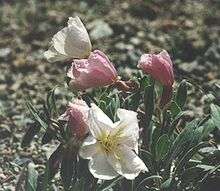Oenothera californica
Oenothera californica, known by the common name California evening primrose, is a species of flowering plant in the evening primrose family.
| Oenothera californica | |
|---|---|
 | |
| Oenothera californica subsp. avita | |
| Scientific classification | |
| Kingdom: | Plantae |
| Clade: | Tracheophytes |
| Clade: | Angiosperms |
| Clade: | Eudicots |
| Clade: | Rosids |
| Order: | Myrtales |
| Family: | Onagraceae |
| Genus: | Oenothera |
| Species: | O. californica |
| Binomial name | |
| Oenothera californica (S.Watson) S.Watson 1876 | |
Distribution
The plant is native to regions of southern and western California, the Southwestern United States, and Baja California, Mexico. It is found in desert and chaparral and woodlands habitats.
Desert ecoregions include the Mojave Desert, Sonoran Desert, and Great Basin Desert.
Chaparral and woodlands ecoregion locations include the southern California Coast Ranges, San Francisco Bay Area, Transverse Ranges, Channel Islands, and Peninsular Ranges.
Description
Oenothera californica is a perennial herb producing a spreading or upright stem up to 80 centimetres (31 in) long. Young plants have a basal rosette of leaves, while older ones have leaves along the stem, lance-shaped to nearly oval in shape and up to 6 centimeters long.
Flowers occur in the upper leaf axils, drooping in bud and becoming erect as they bloom. The four petals are white, fading pink, and may exceed 3 centimeters long.
Subspecies
There are currently three subspecies of Oenothera californica:[1]
- Oenothera californica ssp. avita W.M.Klein 1962 — desert regions.[2]
- Oenothera californica ssp. californica — eastern and Southern California[3]
- Oenothera californica ssp. eurekensis (Munz & J.C.Roos) W.M.Klein 1962 — Eureka Dunes evening primrose.[4]
Eureka Dunes evening primrose
Oenothera californica ssp. eurekensis, the rare Eureka Dunes evening primrose, is a federally listed endangered species endemic to only a few occurrences in the Eureka Valley Sand Dunes in the Eureka Valley of Inyo County, eastern California.[5] It grows alongside another local dune endemic, the endangered Eureka Valley dune grass (Swallenia alexandrae).[6] It is sometimes listed as its synonym Oenothera avita ssp. eurekensis.
The Eureka Valley Sand Dunes are within Death Valley National Park. The main threat to the Eureka Dunes evening primrose was off-road vehicle use. That threat has been reduced and the plant's population has improved, but is still threatened by other human activities and an invasive species of tumbleweed, Prickly Russian thistle (Kali tragus). The United States Fish and Wildlife Service had recommended the plant be removed from the endangered species list.[7]
The former subspecies Oenothera californica ssp. arizonica [(Munz) W.M. Klein 1962], is now considered to be a separate species, Oenothera arizonica [(Munz) W.L.Wagner 1998].
References
- Wagner, W.L et. al. Revised Classification of the Onagraceae (2007)
- CalFlora: Oenothera californica ssp. avita
- CalFlora: Oenothera californica ssp. californica
- CalFlora: Oenothera californica ssp. eurekensis (Eureka Dunes evening primrose)
- California Native Plant Society Inventory of rare and endangered plants: Oenothera californica ssp. eurekensis
- Center for Plant Conservation: Oenothera californica ssp. eurekensis
- USFWS."Oenothera californica" (PDF). Five-year Review. Ecos.fws.gov. September 2007.
External links
- Calflora Database: Oenothera californica (California evening primrose)
- Jepson Manual eFlora (TJM2) treatment of Oenothera californica
- U.C. CalPhotos gallery of Oenothera californica
| Wikimedia Commons has media related to Oenothera californica. |
